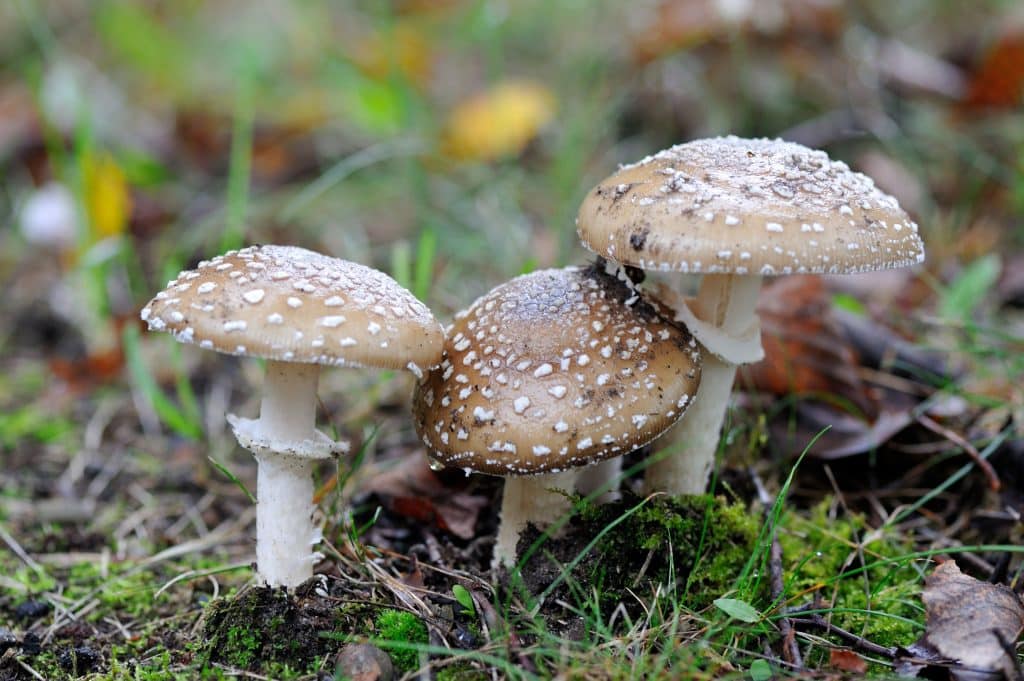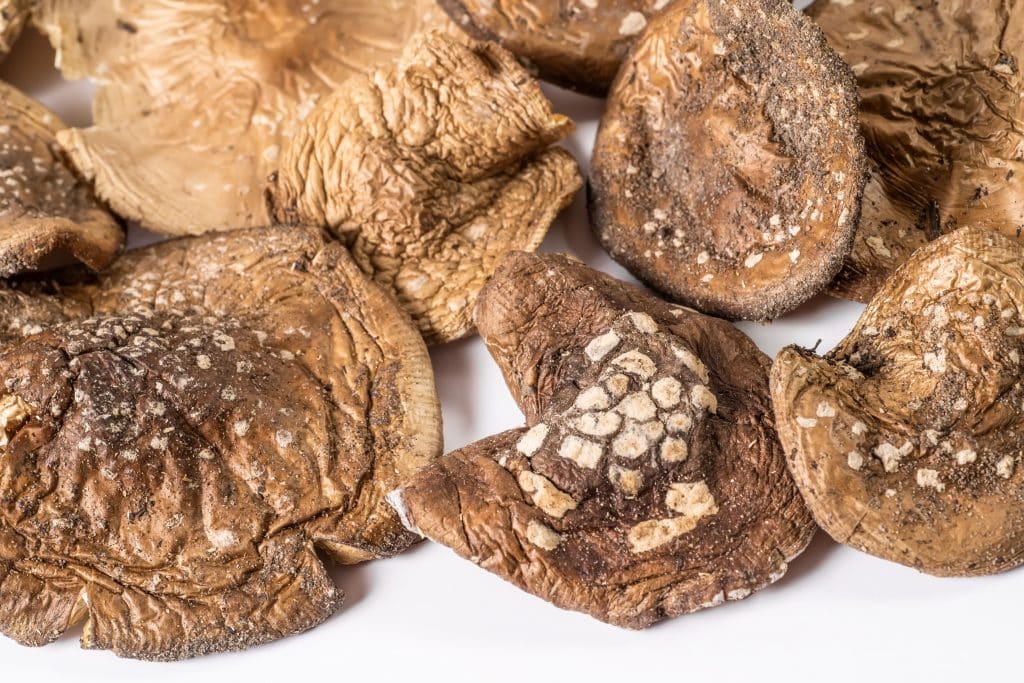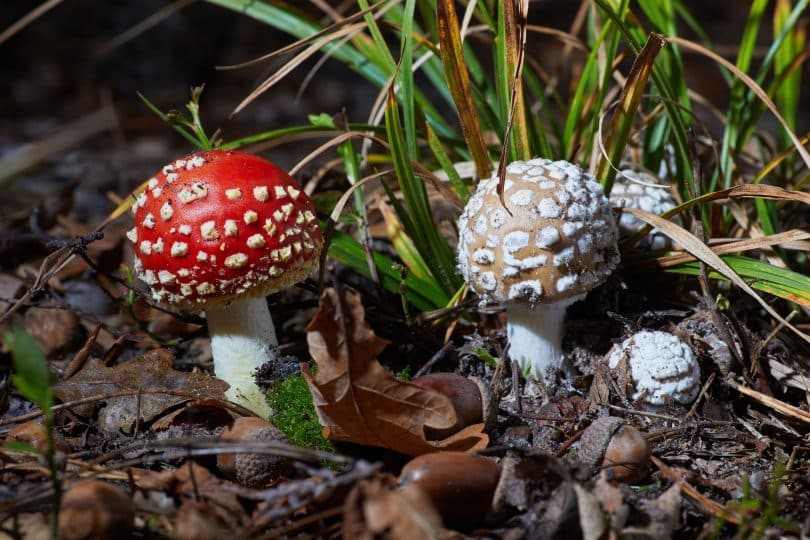Amanita muscaria is gaining prominence for its ability to bring on a hallucinogenic trip, in a different way than the already popular psilocybin mushrooms. So what’s Amanita pantherina? It comes from the same Amanita genus, but is a species all its own. How similar are Amanita muscaria, and Amanita pantherina? And how are they different? Read on to find out.
Amanita pantherina and Amanita mushroom genus
The term ‘Amanita’ doesn’t refer to just one mushroom species, but an entire genus, with many different species underneath it. The genus itself has as many as 600 species which have been identified and studied. This ranges from Amanita phalloides, which have a good chance of killing those who eat them, to Amanita muscaria, which have been used for centuries, or even millennia, for recreational and spiritual purposes. They are known to bring on psychoactive effects and hallucinations.
All Amanita mushrooms are considered ‘poisonous’, though this word is misleading in some cases. Amanita muscaria is known to cause sickness, depending on the amount of a certain compound, ibotenic acid; but apart from one unconfirmed story, no deaths are attached. This is different from its half-brother Amanita phalloides which is responsible for as many as half of all mushroom poisonings; mainly because of toxic compounds called amatoxins.
In this publication, we’re most interested in Amanita muscaria, for both its medical and recreational purposes. As a mushroom which originated in places like Siberia, it simply wasn’t around during the mass illegalization efforts that went on (in the US and beyond) at the end of the last century. It managed to be excluded from this in many countries, retaining legality. And while it does show up in the US, and other parts of the world now; it’s essential invisibility prior to the last several years, helped it stay undercover.
Cool you’re here. Get your direct email updates by signing up for the Cannadelics Weekly Newsletter, which is also bursting with promos for stuff like cannabis buds, vapes, edibles, smoking devices, cannabinoid compounds (like delta-8), amanita products, and plenty more to choose from. Come get the good stuff here!
To be clear, we are not talking about psilocybin mushrooms, the original magic mushrooms. Those mushrooms contain psilocybin and psilocin, the latter of which is a serotonin agonist. Amanita muscaria mushrooms, on the other hand, contain muscimol, a compound that acts as an agonist on GABA receptors.
While psilocybin mushrooms cause hallucinations with an upper effect, Amanita muscaria does something similar (though not the same), with a downer, more relaxing effect. Incidentally, Amanita muscaria mushrooms are more well-known than some think. Their recognizable features of a red head with bright white spots, make them more easily identifiable than most other mushrooms. Think of the game Super Mario Brothers.
Other Amanita mushrooms that contain muscimol, include: Amanita citrina, Amanita gemmata, Amanita porphyria, Amanita regalis, and Amanita strobiliformis. Outside of the Amanita genus, muscimol is also found in Tricholoma muscarium, a mushroom within the Tricholoma genus.
Amanita pantherina – another Amanita mushroom that gets you high
Truth is Amanita muscaria isn’t the only mushroom within the Amanita genus that can cause psychoactive effects. There are other muscimol-containing mushrooms within the genus, including Amanita pantherina. While some mistakenly call this a version of Amanita muscaria, it’s actually its very own species; with some aspects different, and some the same.
Amanita pantherina aka ‘panther cap’, and ‘false blusher’, is not a commonly found mushroom, making most appearances in Europe and Western Asia, particularly in beech and coniferous wooded areas. It’s also found in South Africa and Vancouver Island and other parts of Canada. It’s considered an ectomycorrhizal fungus, meaning its found living symbiotically with trees, among their roots. It gets the products of photosynthesis from the tree, and in turn provides the tree nutrients from the soil.
It has some differences in how it looks, from Amanita muscaria. Instead of a red cap with white spots, Amanita pantherina has a brown cap, that ranges from a dark brown; to a lighter hazel-brown; to a much more pale, sandy-colored, yellowish brown. However, similarly, it’s covered with white spots, or warts. The shape of the cap can range from umbrella-like, to nearly flat, and it contains gills underneath it. These mushrooms have a fleshy boot-like tissue mass that covers the bottom.

Much like its half-brother Amanita muscaria, Amanita pantherina contains both ibotenic acid, and muscimol. The former enabling sickness, and the latter bringing on the nice trippy and relaxing psychoactive effects. Because of the inclusion of ibotenic acid, these mushrooms can cause sickness akin to Amanita muscaria, but can also be prepared by boiling to remove this toxin. Though it can make a person sick, and is classified as ‘poisonous’, like all Amanita mushrooms; it’s not associated with death.
These mushrooms are actually more capable of bringing on sickness than their Amanita muscaria half-brothers, just for the sheer fact they contain more ibotenic acid. This means eating them raw, is much more likely to come with sickness. On the other hand, since that ibotenic acid can be decarboxylated to muscimol, it also means a higher amount of muscimol than Amanita muscaria, which makes them stronger mushrooms.
How to prepare Amanita pantherina?
When it comes to half-brother Amanita muscaria, some people risk it and eat the raw mushrooms. And plenty get sick because of this. Some look for dried caps, which have naturally through time allowed for some of the ibotenic acid to convert to muscimol, making them less sick-inducing. But the main way to prepare them is by boiling. As both compounds are water soluble, they both leach out, with some recipes saying 15 minutes is fine, and others saying if you want the job done completely, to do more like a full hour or more. There are also variations that include adding salt or vinegar to help the compounds leach out.
The great thing about muscimol is that its not heat sensitive in the same way as ibotenic acid, meaning it remains stable in boiling temperatures, even if for hours. So the end product is a ton of muscimol, and little-to-no ibotenic acid. This is similar to psilocybin mushrooms, which actually depend on psilocybin converting to psilocin in the body (as that’s the compound that causes effects). The more psilocybin, the stronger the mushroom, even if its not the needed compound in the end. An Amanita muscaria mushroom with more ibotenic acid, will result in a higher level of muscimol for the final product.
When it comes to Amanita pantherina, it’s that much less wise to eat them raw, or even dried. In fact, with these mushrooms, unless you’re looking for a bad time, you’re going to want to boil them and make the tea. The ibotenic acid content is too high to eat them without this processing, plus, the processing makes them that much stronger, by adding that much more muscimol through decarboxylation. And without requiring your body to do it while sick from the ibotenic acid. I can’t stress enough, these mushrooms should not be eaten fresh or unprocessed.
The main reason for understanding the difference between Amanita muscaria and Amanita pantherina is in the need for boiling. While you can risk it (and still get sick) with the former, you’re almost universally looking at a bad time with the latter when not made correctly. So while amateurs might group them together in terms of ‘amanita mushrooms that get you high’, they are certainly not the same thing.

These mushrooms are often confused for another Amanita species, Amanita excelsa. While Amanita excelsa is generally considered edible, its often hard to tell the difference between the two. Those on the hunt for wild edible mushrooms, and who plan to eat them raw, should be very careful not to make this mistake.
Some interesting Amanita history
We’ve spoken plenty about these mushrooms (both species) being a part of cultural traditions in places like Siberia and Northern Europe. But they’re also indicated in other places and in other time periods. As per a ScienceDirect article:
“The psychoactive Amanita mushrooms, specifically Amanita muscaria and Amanita pantherina, have a well-attested entheogenic use among Siberian, European, and Pan-American shamanic peoples and are specifically implicated in the Mysteries of ancient Greece (especially the Mysteries of Dionysus), Rome (Mithraic Mysteries), and as the original Vedic plant-god soma, and Avestan haoma among the gnostic Manicheans and early and mystically inclined Christians of later periods.”
In more recent history, the mushroom was first described by Augustin Pyramis De Candolle, a Swiss-born mycologist, who originally named it Agaricus pantherinus in 1815. German mycologist Paul Kummer updated this in 1971, to its present day place as Amanita pantherina.
One of the other interesting historical aspects of these mushrooms (muscaria and pantherina) is that according to historical accounts, one method that was once employed to get rid of the ibotenic acid, was to drink the urine of a person (or, yes, a reindeer) who had already eaten the mushrooms. This is because a human or animal body decarboxylates the ibotenic acid into muscimol, which then remains unchanged in the urine. The pee method is a way to get rid of the poison, and change it over to muscimol. Obviously, it comes with the pretty heavy negative of consuming urine, and isn’t an advisable method today.
Conclusion
So there you have it, not all Amanita mushrooms are the same, even when it comes to getting high. For those interested in Amanita pantherina, just make sure to boil them well. You should get a great response, but remember that even more than Amanita muscaria, they can cause sickness when not prepared correctly. Here’s to a great mushroom experience!
Hello all! Welcome to Cannadelics.com; an independent news site geared toward reporting on the expanding cannabis and psychedelics fields. Head this way whenever you can to keep in-the-loop on important topics, and subscribe to the Cannadelics Weekly Newsletter, so you’re never late to get a story.









